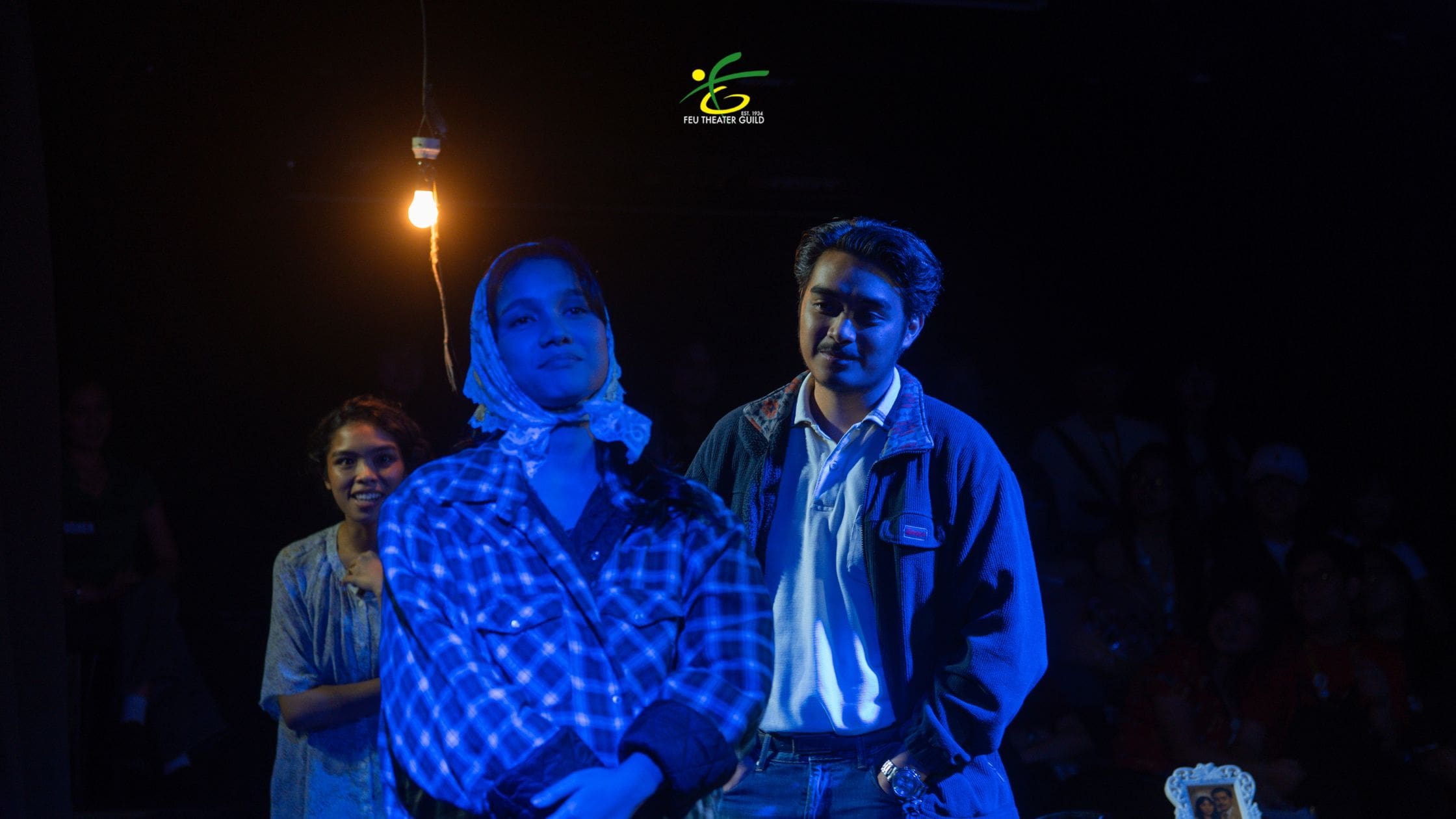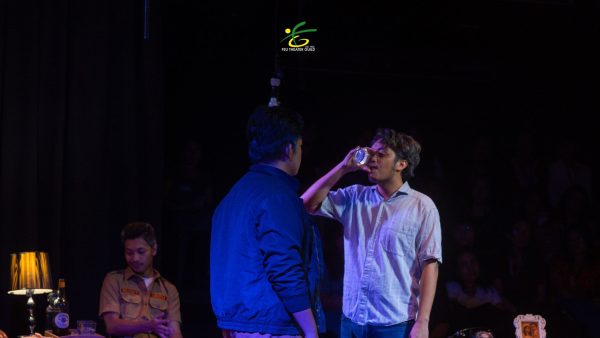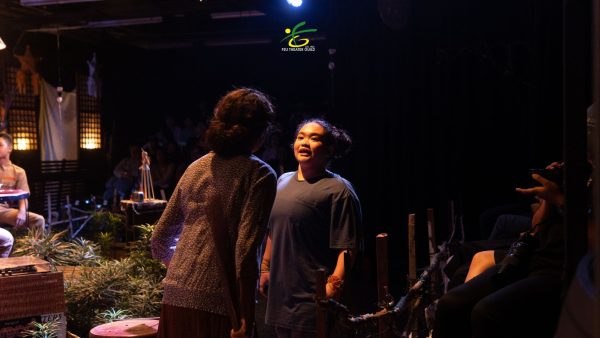
UNI-BASED REVIEW: FEU Theater Guild’s ‘Karne’
In Dudz Teraña’s ‘Karne’, a marriage rots from tenderness to terror. The play simmers with female rage, showing how domestic oppression leaves only the bitter aftertaste of spoiled love.
In Karne, female rage becomes the pulse of suspense and the source of its most terrifying moment. Directed by Dudz Teraña, the production adapts Roald Dahl’s short story “Lamb to the Slaughter” and turns the private space of marriage into a site of fear.
Karne follows a clever structure that begins in the present, immediately setting up the dramatic question that anchors its mystery frame, before shifting into the past to trace the unraveling life of the couple. It opens with Mary (Julia Ramas) going about her usual day: waiting at the table, praying at the altar, going to the market, and cooking, when three policemen, Elnar (Arvin Javier), Enopia (Justin Abalos), and Credo (Dave Bambang) arrive. The throwback sequences introduce Patrick (Rafaelle Pascua) first as the police chief and later as a domineering and aggressive husband, alongside Mary who appears timid, obedient, and defined only by her role as a housewife.
The play treats Mary’s restraint as a slow burn, layering silence, denial, and repression until the tension is impossible to ignore. Each scene adds to the weight pressing down on her, so that when the breaking point arrives, it feels inevitable. By the end, female rage emerges as the terrifying force the production has been building toward.
A Filipino Home Brought to the Stage
The production stands out with Beatrize Villareal’s (Production Designer) staging that resembles a fully lived-in Filipino home. The design integrates a living room, dining area, and a prominently featured kitchen, connected by a small hallway leading to the unseen bedroom of the couple. The kitchen functions as the centerpiece, equipped with a working stove, faucet, and sink that allow Julia Ramas, as Mary, to cook and wash dishes in real time. This domestic activity begins even before the play formally opens.

L-R: Justin Abalos [Enopia], Arvin Javier [Elnar], Rafaelle Pascua [Patrick]; Photo Credit: FEU Theater Guild
At the center of the living room stand the household objects that later gain symbolic weight: a record player and an old telephone. Mary is noticeably confined to two spaces—in the kitchen and the dining table. In the kitchen, she is almost always preoccupied with cooking. When she is not, she waits quietly at the dining area for Patrick’s return. The record player fills the silence in her husband’s absence, while the telephone eventually becomes a tool for a calculated plan.
Although the play is set in 1980s Zamboanguita, Negros Oriental during Martial Law, this backdrop has little visible effect on the characters’ daily lives. The terror of the period is not fully explored, and the story might as well exist in another decade. Without the direct mention of Martial Law in a conversation between Patrick (Rafaelle Pascua) and his police colleagues Elnar (Arvin Javier), Enopia (Justin Abalos), and Credo (Dave Bambang), its presence would hardly register.
On the other hand, the parol and Christmas tree placed on stage are reminders of the season, yet the dim yellow lights darken the stage and create an eerie atmosphere (lighting design by Dave Bambang). The set also uses three LED bulbs placed across the stage as cues for the characters. They switch these on and off to mark monologues during interrogations or whispered gossip.
In the climax, the lighting delivers the production’s most striking effect. The stage plunges into darkness, while pounding sounds, shouts, and a single red light pierce through the living room toward the portrait of The Last Supper on the kitchen wall. This design heightens the suspense and lets the most harrowing moment unfold without showing it directly.
Meaty Cast Performances
The weight of this story, centered on domestic abuse, toxic masculinity, and female rage, rests heavily on the performances. Each scene, the cast shifts from the lightness of playful banter among friends to the intensity of heated confrontations all while code-switching between Bisaya, Filipino, and English. Julia Ramas as Mary delivers a powerful portrayal of repressed anger exploding into despair. She shows remarkable ability to capture emotional complexity, with her howls carrying a mix of fury and grief. To balance this intensity, the production intersperses lighter moments through the banter of Mary’s friends Dante, Ellen, and Maloi. Jharelle Villalobos as Dante delivers memorable comic relief, turning his character’s lustful jokes into moments of lightness rather than malice. Meanwhile, Maria Ysabel Delos Reyes as Ellen commands the stage with her firm and empowered presence, giving sufficient weight to the scene where she confronts Patrick directly.

L-R: Bjorn Pestaño [Maloi], Heleina Li [Estang]; Photo Credit: FEU Theater Guild
Heleina Li as Estang, the spirited child living with her grandmother Mrs. Poblacion (Cassy Herilla), brings a lighter touch to the play. Her playful defiance in the face of adult teasing, paired with her natural energy, balances tenderness with the story’s darker moments.
Too Much Flesh, Not Enough Bone
However, despite the delightful performances of the supporting characters, their roles in the play remained largely limited to entertainment. They were compellingly introduced but lacked sufficient weight in the story. Aside from being defined by their occupations—Dante as a city hall employee, Ellen as a teacher, and Maloi as a housewife—they were not given fuller lives beyond these functions. Estang and, in particular, Mrs. Poblacion also carried little significance in the progression of the plot, serving mainly as sources of comic relief or gossip. One of the most overlooked figures is Samuel (Julian Anabo), Mary’s delivery boy. Although his character is initially introduced with hints of deeper involvement, the thread remains underdeveloped and he comes across merely as a filler presence.
Patrick (Rafaelle Pascua), on the other hand, emerges as the most enigmatic character, but this ambiguity exposes one of the play’s loopholes. His abrupt shift from a charismatic, persistent suitor into a darker presence is thinly motivated and lacks depth. This weakness may be traced to the play’s underdeveloped link between the Martial Law backdrop and the intimate dynamics of the couple, particularly Patrick’s role as a policeman. The play also introduced at the end a supposed catalyst for his change, yet as there was no careful build-up for this, this reasoning feels unconvincing.
Though Pascua succeeds in embodying the dread and menace of the husband’s presence, some of the couple’s arguments and Patrick’s outbursts appear unmotivated, with no clear triggers. As a result, certain confrontation scenes come across as strained. This is most evident during the first instance of physical violence upon discovering that Mary had been selling tube ice, an escalation that felt unearned.
Overall, Karne delivers a gripping drama, anchored by its central theme of female rage as both terrifying and transformative. It shows how oppressive relationship dynamics culminate in a gristly outcome and leaves us with an unsettling aftertaste.
Tickets: 200 PHP (Student), 500 PHP (Guest), and 700 PHP (VIP)
Show Dates: September 11, 2025 to November 8, 2025
Venue: FEU Center for the Arts Studio, Engineering Building
Running Time: 2 hrs
Company: Far Eastern University Theater Guild
Creatives: Dudz Teraña (Director), Kirstan Orbegoso (Assistant Director), Maria Ysabel Delos Reyes (Production Manager), Charlene Libo-on (Head Stage Manager), Kevin Ricaforte (House Manager), Beatrize Villareal Production Designer), Justin Abalos (Costume Designer), Shawn Tarala (Sound Designer), Dave Bambang (Lights Designer), Jharelle Villalobos (Creative Head), Trisha Tan (Marketing Head); Khean Bañez (Multimedia Head), Irish Oliveros (Public Relations Head), Sheila Peralta (Language Coach for Cebuano)
Cast: Julia Ramas, Maria Mayano, and Janae Dionisio (Mary); Rafaelle Pascua, Ron Bayani, and Arvin Javier (Patrick); Arvin Javier and Shawn Tarala (Elnar); Julian Anabo, Migi Mesina, and Marc Ducut (Samuel); Kristian Samson, Justin Abalos, and Aldin Covarrubias (Enopia); Dave Bambang and Kirstan Orbegoso (Credo); Bjorn Pestaño, Marga Barrameda, and Sheila Peralta (Maloi); Jonas Cunanan, Renz Dotillos, and Jharelle Villalobos (Dante); Dianne Andallo and Maria Ysabel Delos Reyes (Ellen); Cassandra Herilla, Trisha Tan, and Irish Oliveros (Mrs. Poblacion); Lorenze Moral and Nash Desoyo (Estong) and Heleina Li (Estang)


Comments